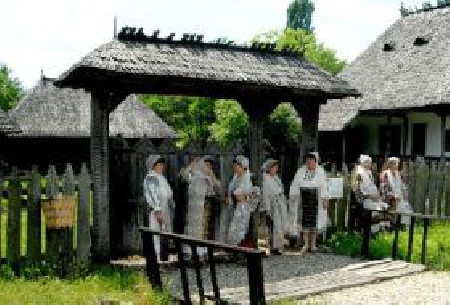The Vine and Fruit Growing Museum in Golesti
The village of Stefanesti, about 6 kilometers away from Pitesti, in central Romania, hosts the Golesti Museum. The large compound, stretching several hectares, comprises the Golescu familys medieval residence, as well as an open-air museum: the Vine and

Eugen Cojocariu, 29.04.2012, 17:52
The village of Stefanesti, about 6 kilometers away from Pitesti, in central Romania, hosts the Golesti Museum. The large compound, stretching several hectares, comprises the Golescu family’s medieval residence, as well as an open-air museum: the Vine and Fruit Growing Museum.
Bordered by walls whose height ranges from 5 to 22 meters, and covering an area of 4 hectares, the Golesti Medieval Compound is Romania’s only secular fortified construction. Here is the director of the Golesti Vine and Fruit Growing Museum, Filofteia Pally, with details on the history of the construction.
Filofteia Pally: “The mansion was founded in 1640 by Stroe Leurdeanu and Visa from Golesti, but the 1716 fire destroyed a great part of the building and its outhouses, so that Radu Greceanu, then governor of the region, had it rebuilt in the 18th century. The Golesti family’s medieval compound is typical for the age preceding the time of Brancoveanu-style palaces. Actually it is typical of the old Romanian architecture, which sadly has been preserved in a very limited number of locations in Romania. Master Stoica, brought over to Wallachia by ruling prince Matei Basarab to erect a string of monuments, is the true founder of the compound. Master Stoica brought Moldavian influences, but here he worked with a team of masons from Muscel, so the building illustrates a typically Wallachian architectural style.”
Governor Radu Golescu, one of Wallachia’s far-sighted boyars, is Dinicu Golescu’s father. Dinicu Golescu was a forward-looking boyar himself, as well as a writer, whose diary entitled “The Account of the Journey I, Constantin, made in the years 1824, 1825, and 1826” was indeed groundbreaking, since it was the first Romanian book focusing on a journey to the West. Dinicu Golescu tried to apply at home what he saw during his travels. A telling example in this respect is the first rural school, founded in 1826 in Golesti. And today’s museum venues a permanent exhibition, reminding visitors of that first Romanian school.
The mansion in Golesti became a museum in June 1939, and underwent large-scale restoration works in 1942-1944. Since 1958, the medieval compound has been hosting permanent exhibitions. Filofteia Pally, director of the Fruit and Vine Growing Museum in Golesti again:
Filofteia Pally: “A memorial exhibition of the Golesti family, the 19th century generation, has been mounted within the museum. At the entrance, in the watchtower, there is only one room housing an exhibition that focuses on the 1821 revolution led by Tudor Vladimirescu. On the left of the watchtower, there is an exhibition devoted to the high school in the countryside and on its right, there is the old infirmary, where we mount various temporary exhibitions. Behind the mansion, there is the Turkish bath, the only construction of this kind entirely preserved in Romania.”
The open-air section, the actual vine and fruit growing museum, stretches over 10 ha and is arranged as a village museum made up of over 35 peasant households. Filofteia Pally:
Filofteia Pally: “Another annex on the north-western side houses an exhibition of ethnography and folk art in Arges County. Beyond the walls of the medieval compound covering an area of 4 ha, there is the open-air sector, which is a miniature map of Romania with fruit and vine-growing areas from all over the country. We also take pride in one of the most valuable collections of grapes and other fruit processing outfits, such as wine presses or boilers. There tourists have the opportunity of participating in fruit processing by using old techniques, in making plum brandy in the plum brandy boiler or in pressing grapes in vats.”
A walk along the lanes of that traditional Romanian village is advisable both in summer and in winter, when they are covered in snow. Exhibits from the Vine and Fruit Growing Museum in Golesti are featured on this year’s QSLs of Radio Romania International.






























